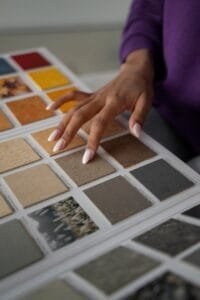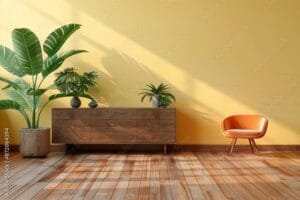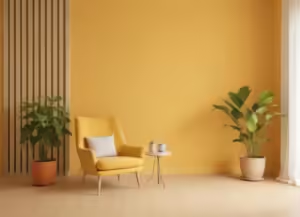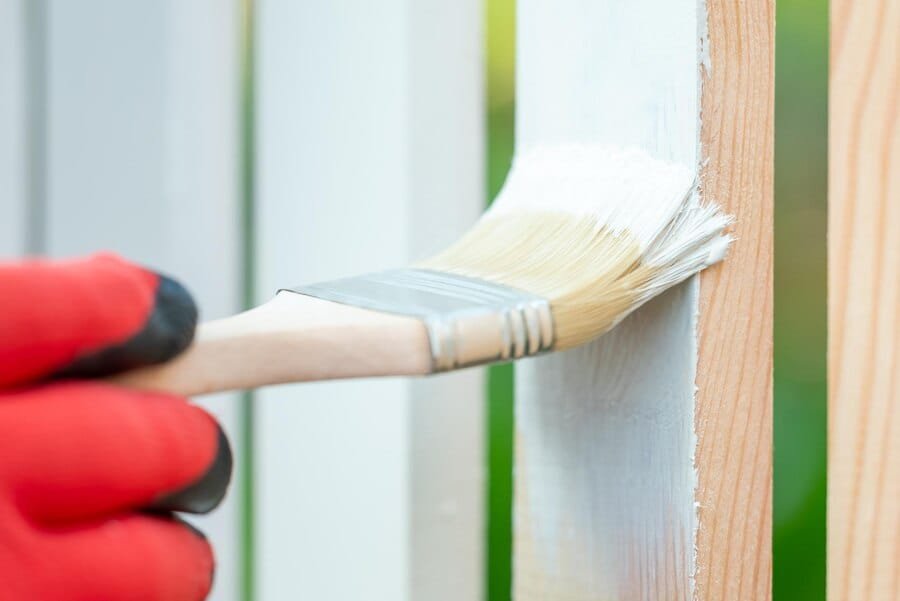Introduction to Right Texture
Wall textures play a crucial role in the field of interior design, serving not only as a decorative aspect but also as an integral component that influences the overall ambiance of a space. The texture of a wall can significantly impact the perceived size, warmth, and mood of a room, making it an essential consideration for both residential and commercial interiors. Textures can evoke a variety of emotional responses; for instance, smooth surfaces often convey a sense of calm and sophistication, while rough, tactile finishes may create a more dynamic and inviting atmosphere.
In addition to contributing to the aesthetic appeal, wall textures can enhance the psychological well-being of occupants. The choice of texture can lead to feelings of comfort, energy, or creativity, depending on how it resonates with the individuals inhabiting that space. This emphasizes the importance of selecting the right textures to align with the intended use of the room, whether it be a cozy living area, a stimulating workspace, or a relaxing retreat.
There exists a diverse array of wall textures available for consideration. From smooth finishes such as plaster and paint to more intricate choices like wallpaper and textured finishes made of wood or stone, the options are virtually limitless. Each texture type has its unique characteristics, maintenance requirements, and suitability for various settings. Moreover, textures can be layered or combined to create a more personalized effect, allowing for creative expression in interior spaces.
As we delve deeper into the various types of wall textures, it is essential to recognize their potential to transform an environment, creating a foundational layer of beauty and functionality. Understanding the significance of wall textures will empower homeowners and designers alike to make informed decisions that enhance the overall design narrative of their spaces.
Understanding the Different Types of Wall Textures
When selecting a wall texture for your home, it is essential to understand the various options available. Each type of wall texture offers distinct aesthetics and can significantly influence the overall style of your spaces. The most common wall textures include smooth, stucco, knockdown, and others, each with its unique characteristics and best-use scenarios.
A smooth wall texture creates a clean, modern look that is highly versatile. It can be painted in any color, allowing for a broad range of decorative options. Smooth surfaces are particularly suitable for contemporary-style homes, as they provide a sophisticated backdrop for artwork and furnishings. Additionally, they are easy to clean and maintain, making them ideal for high-traffic areas like hallways and living rooms.
Stucco textures, often associated with Mediterranean-style architecture, provide a rustic charm. This plaster-based texture can be applied in various thicknesses, offering both a visual and tactile element to walls. Stucco is highly durable and weather-resistant, making it an excellent choice for exterior applications. In interior settings, stucco can evoke a sense of warmth and earthiness, easily fitting into a variety of design schemes.
Knockdown texture, achieved by applying a layer of joint compound to walls and then “knocking down” the peaks with a trowel, creates a more dynamic surface. This type of wall texture features a slightly mottled appearance and is popular in casual and contemporary interiors. Its forgiving nature makes it an appealing choice for concealing imperfections in drywall. Knockdown textures work well in various rooms, including family areas and bedrooms, adding character without overwhelming the space.
In addition to these popular options, there are several other textures to consider, such as slap brush and sand, which can add unique touches to your walls. Each wall texture type has its application areas and complements specific architectural styles, making it crucial for homeowners to evaluate their preferences and space requirements carefully.

Factors to Consider When Choosing a Texture
Choosing the right texture for walls is a significant aspect of interior design that can greatly influence the overall ambiance of a space. Various factors must be evaluated to ensure that the selected texture complements the overall design and functionality of the room. One of the most critical factors is the size of the room. In smaller spaces, lighter textures may create an illusion of depth, making the area feel more expansive. Conversely, larger rooms can benefit from bolder textures that add warmth and coziness.
Natural light is another crucial element to consider when selecting wall textures. Rooms that receive abundant natural light may handle darker or more complex textures without feeling oppressive. On the other hand, spaces with limited light benefit from lighter textures, which can help reflect light and make the room feel brighter. Understanding how light interacts with the wall surface can aid in creating a harmonious environment.
The color scheme of the room also plays an important role in texture selection. The chosen texture must align with the existing color palette; thus, it is advisable to consider how textures can influence color perception. Textures can either soften the impact of bold colors or enhance the visual appeal of neutral tones. Moreover, existing decors, such as furniture and artwork, should be taken into account when selecting a wall texture. A cohesive look is best achieved by ensuring that the texture harmonizes with the surrounding elements.
Finally, the functionality of the room influences texture choice. High-traffic areas may require more durable textured surfaces, while personal spaces like bedrooms may benefit from softer, more inviting textures. By evaluating these critical factors—room size, natural light, color schemes, existing decors, and functionality—homeowners can select a wall texture that not only enhances aesthetics but also serves practical needs.

The Role of Functionality in Texture Selection
Choosing the right texture for walls is not merely an aesthetic decision, but one heavily influenced by the functionality required in specific spaces. As different areas of a home serve distinct purposes, the texture selected should align with both the practical and visual demands of each room. For example, kitchens and bathrooms, which are frequently exposed to moisture and splatters, benefit from wall textures that are easy to clean and resistant to stains. In such cases, a smooth or semi-smooth finish can be advantageous as it minimizes the surface area that needs cleaning and can often be wiped down easily.
Durability is another critical factor to consider when selecting wall textures. High-traffic areas, such as hallways or children’s rooms, require materials that withstand wear and tear. Textures that resist scuffing, such as resilient vinyl wall coverings or those specifically designed for heavy-duty use, are ideal for these applications. Moreover, walls in children’s rooms should combine practicality with creativity; therefore, incorporating washable textures can facilitate maintenance while providing engaging and fun designs.
Maintenance requirements should also be evaluated. Some textured finishes may require more upkeep than others, impacting long-term usability and aesthetic appeal. For instance, highly patterned textures or those with intricate designs might accumulate dust and grime more readily, necessitating regular cleaning or even repainting. Understanding the long-term implications of each texture’s maintenance can help you choose a finish that remains both visually pleasing and functional over time.
In summary, the selection of wall textures should be thoroughly guided by the specific functional needs of each room. By prioritizing ease of cleaning, durability, and maintenance, you can create a living space that is not only beautiful but also highly functional, thereby enhancing the overall experience of your home.

Matching Texture to Room’s Purpose
Choosing the right wall texture is crucial for enhancing the overall ambiance of a room. The purpose of each space significantly influences the selection of textures, as they can evoke different feelings and functionalities. For instance, in living rooms, which are primarily social spaces that encourage interaction and relaxation, a softer texture can create a welcoming environment. Options like a smooth or lightly textured plaster finish can enhance a sense of comfort while also allowing for easy maintenance and decoration.
Conversely, in dedicated workspaces, such as home offices, a more structured texture can help foster concentration and productivity. A subtle textured finish, such as a slight concrete or wood grain, adds character without overwhelming the senses. These types of textures support a professional atmosphere, essential for maintaining focus during work tasks. Additionally, colors accompanying these textures can also play a pivotal role, where cooler colors often promote calm and focus, making them suitable for areas designed for productivity.
In areas such as bedrooms, a softer texture not only provides warmth but also contributes to a restful atmosphere. A fabric-like wallpaper, for example, can create a cozy environment conducive to relaxation and sleep. On the other hand, bathrooms often benefit from textured surfaces that provide slip resistance, such as textured ceramic tiles, which can enhance both safety and style. Each room’s specific purpose must be considered when selecting wall textures to ensure they align with the intended use.
Ultimately, being mindful of how texture complements a room’s functionality can lead to more harmonious and enjoyable living spaces. With thoughtful integration of textures appropriate to each environment, homeowners can create a balanced aesthetic that caters to both practical needs and personal style.

Popular Trends in Wall Textures
In recent years, wall textures have evolved significantly, becoming a crucial element in interior design that not only enhances aesthetics but also contributes to the overall atmosphere of a space. One of the most notable trends is the use of natural materials, such as stone and wood, which impart an organic feel to interiors. For instance, textured stone accent walls can evoke a sense of luxury and earthiness, making them an excellent choice for living rooms or entryways. Similarly, reclaimed wood paneling has gained popularity for its rustic charm and ability to create warmth in any environment.
Another emerging trend in wall textures is the use of geometric patterns. Wallpapers and textured paints are now available in various shapes and designs, offering options that range from subtle reliefs to bold statements. These patterns can be employed as accent walls or throughout a room to add depth and visual intrigue. Additionally, textural paint finishes, such as sponging or rag rolling, enable homeowners to add dimension without overwhelming the space. Such techniques are particularly appealing for contemporary styles, where minimalism meets artistic expression.
A noteworthy trend is the rise of tactile surfaces incorporating fabric or textile-like finishes. Velvet or linen finishes on walls create an inviting atmosphere, promoting comfort and warmth. Such textures not only serve a decorative function but also improve acoustics within a room. This trend aligns with the increasing focus on creating spaces that foster well-being.
Incorporating popular textures into your home requires thoughtful consideration of the overall design scheme. Utilizing complementary colors and ensuring a cohesive style will enhance the impact of selected textural elements. By staying attuned to these trends, homeowners can make informed choices that elevate their spaces while reflecting personal style and preferences.

Combining Textures for a Layered Look
Creating a visually appealing space often involves the strategic use of different wall textures. Layering textures can add depth and interest, transforming a mundane environment into a captivating one. By combining various materials and finishes, it is possible to achieve a harmonious balance that enhances the overall aesthetic of a room.
To effectively layer textures, it is essential to consider the existing elements within the space. For instance, pairing a smooth, polished surface like drywall with a rough texture, such as exposed brick or a stone wall, can create an intriguing contrast. This juxtaposition not only captures the eye but also adds dimension to the room. Additionally, integrating textiles, such as fabric wall coverings or wall hangings, further enriches the sensory experience, allowing for a more inviting ambiance.
Choosing a cohesive color palette can enhance the effectiveness of combined textures. Subtle variations in shades can provide depth, while a limited color range ensures that the textures don’t compete for attention. For example, utilizing shades of gray on smooth walls with natural wooden beams can evoke a serene atmosphere, emphasizing the warmth of the wood while maintaining a sleek look through the walls.
Moreover, focusing on the scale of textures is vital. In rooms with high ceilings, large textured elements can be employed, such as oversized panels or extensive plaster finishes, to help ground the space. In contrast, smaller rooms may benefit from more delicate textures, which can create an illusion of openness and airiness.
Combining textures effectively is not only about mixing them but also about understanding their interplay within a space. By thoughtfully selecting and layering various wall textures, it is possible to curate an inviting environment that speaks to one’s design sensibility and preferences.

Budgeting for Wall Textures
Choosing the right texture for walls involves not only aesthetics but also budgeting effectively. Understanding the financial implications can help homeowners make informed decisions that align with their overall design goals. The initial step in budgeting for wall textures is assessing the cost of materials. Various texture options like stucco, plaster, or paint can differ significantly in price. For instance, while paint may be more economical, textured finishes like plaster might carry a higher material cost but offer a unique appeal and durability.
Next, labor costs play a crucial role in determining the overall budget for wall textures. Depending on the complexity of the chosen texture, the skill required for application can vary. Hiring a professional may ensure a superior finish but can add to the project expenses. It is essential to obtain multiple quotes from contractors specializing in wall textures to compare prices and services. This assessment will provide a clearer understanding of the labor investment necessary to achieve the desired design.
Moreover, long-term maintenance should not be overlooked when budgeting for wall textures. Certain materials may require regular upkeep or repair, influencing future costs. For example, while textured walls can enhance aesthetic value, they may accumulate dust and grime, necessitating more frequent cleaning or refinishing than smooth walls. Homeowners should consider these ongoing costs when determining their budget, as they can significantly affect total expenditures over time.
In conclusion, successfully budgeting for wall textures entails a comprehensive evaluation of material costs, labor fees, and long-term maintenance requirements. By carefully balancing these elements, homeowners can select a texture that not only fits their design aspirations but also aligns with their financial capacity, ensuring a sustainable investment in their property.

Conclusion and Final Tips
Choosing the right texture for walls is an essential aspect of interior design that can profoundly impact the overall ambiance of a space. Throughout this blog post, we explored various factors to consider when selecting wall textures, including the style of your home, the function of the room, and individual preferences. Recognizing the interaction between different textures and lighting, as well as their contribution to the overall aesthetic, is crucial in making an informed decision.
Firstly, consider the design style you wish to achieve. Whether contemporary, traditional, or eclectic, your wall texture should align with the overall theme of the room. For example, smooth finishes might complement a modern aesthetic, while textured finishes such as stucco or plaster can enhance a more rustic or traditional setting. It is also vital to visualize how different textures interact with furnishings and architectural elements in your space.
Next, reflect on the function of the room. High-traffic areas may benefit from durable textures that withstand wear and tear, while a serene bedroom can feature softer textures that evoke calmness. Always keep in mind how the texture will influence not only the visual appeal but also the practicality of maintaining the walls.
When embarking on selecting wall textures, take the time to sample different options in your space. Observing them under various lighting conditions can help you assess their true appearance. Additionally, considering the color palette can enhance the knowledge of how textures work together.”
By keeping these tips in mind, you can confidently choose the appropriate wall texture that reflects your style and meets your spatial needs. Assessing the discussed factors will ensure a harmonious integration of wall textures into your home, creating an inviting and aesthetically pleasing environment.


